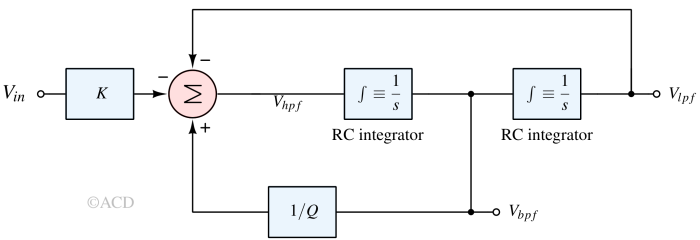State variable filters¶
A state variable filter (or universal active filter) has simultaneous outputs, i.e., low-pass, high-pass, and band-pass. It allows changing all three of the main filter parameters, Gain (A), cutoff/center frequency (fC), and Quality factor (Q), independently, without affecting the performance of the filter. This flexibility comes at an expense of more circuit components and higher power consumption.
KHN biquad filter¶

The KHN (Kerwin, Huelsman, and Newcomb) employs three operational amplifiers, six resistors, and two capacitors. Within this circuit, the output of the first operational amplifier yields a high-pass response, the second generates a band-pass response, and the third produces a low-pass response.

Tow-Thomas biquad filter¶
It is close to a state variable filter with only bandpass and lowpass outputs. There is no highpass output. There is an inverter in the bandpass filter. This extra inverter is not required in a fully differential implementation because we have both inverting and non-inverting outputs.

Applications¶
Since the parameters of a state variable filter are independently tunable, it is easy to add electronic control of frequency, Q, and ω0. The tuning uses an analog multiplier, MDACs, or digital potentiometers.